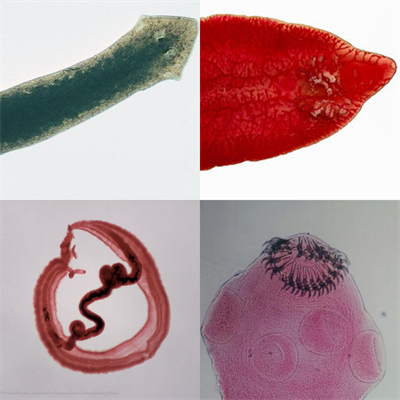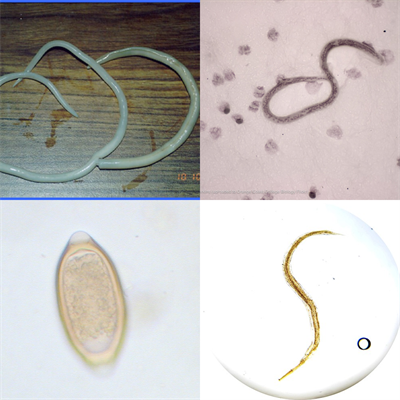PDF chapter test TRY NOW
Platyhelminthes:
These animals have a more complexly designed body than the Poriferans and Cnidarians. They are free-living or parasitic animals.
The body design of Platyhelminthes:
- Their body can be divided into two equal halves. Hence, they are bilaterally symmetrical
- They have three layers of cells that make up differentiated tissues. Hence, they are known as triploblastic animals
- Due to this, their body comprises of outside and inside body linings and organs for specific functions
- They lack segmentation
- They are acoelomates
- As their body is flattened dorsoventrally (meaning from top to bottom), they are commonly known as flatworms

Clockwise from top left: Planaria, Fasciola hepatica (Liver fluke), Blood fluke, Taenia solium (tapeworm)
Nematoda:
These are parasitic worms that cause diseases such as elephantiasis and filariasis. These are sexually dimorphic animals - female and male worms are distinct.
Body differentiation of nematodes:
- These are bilaterally symmetrical, triploblastic animals
- They have a cylindrical body rather than the flattened one, and hence they are commonly known as Roundworms or Pinworms
- They have tissue-level of organisation
- They lack organs
- These are pseudocoelomates

Clockwise from top left: Ascaris lumbricoides (roundworm), Wuchereria bancrofti (filarial worm), Trichuris (whipworm), Enterobium vermicularis (pinworm)
Reference:
https://www.flickr.com/photos/carolinabio/8225394736
https://upload.wikimedia.org/wikipedia/commons/thumb/4/43/Fasciola_hepatica_%28Linnaeus%2C_1758%29_2013_000-2.jpg/512px-Fasciola_hepatica_%28Linnaeus%2C_1758%29_2013_000-2.jpg
https://www.flickr.com/photos/occbio/6414501563
https://upload.wikimedia.org/wikipedia/commons/9/9b/Taenia_solium_scolex_x400.jpg
https://www.flickr.com/photos/gtzecosan/15701719491
https://www.flickr.com/photos/occbio/6414497563
https://www.flickr.com/photos/gtzecosan/15703630875
https://upload.wikimedia.org/wikipedia/commons/thumb/e/e5/Enterobius_vermicularis-1.jpg/512px-Enterobius_vermicularis-1.jpg
https://upload.wikimedia.org/wikipedia/commons/thumb/4/43/Fasciola_hepatica_%28Linnaeus%2C_1758%29_2013_000-2.jpg/512px-Fasciola_hepatica_%28Linnaeus%2C_1758%29_2013_000-2.jpg
https://www.flickr.com/photos/occbio/6414501563
https://upload.wikimedia.org/wikipedia/commons/9/9b/Taenia_solium_scolex_x400.jpg
https://www.flickr.com/photos/gtzecosan/15701719491
https://www.flickr.com/photos/occbio/6414497563
https://www.flickr.com/photos/gtzecosan/15703630875
https://upload.wikimedia.org/wikipedia/commons/thumb/e/e5/Enterobius_vermicularis-1.jpg/512px-Enterobius_vermicularis-1.jpg
